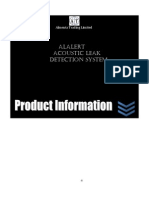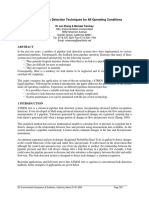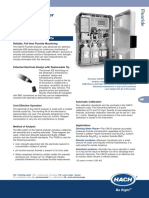0 ratings0% found this document useful (0 votes)
54 viewsSmartball Case Study: May 27 2008 Plains Midstream Canada - North Ferrier Lateral
Smartball Case Study: May 27 2008 Plains Midstream Canada - North Ferrier Lateral
Uploaded by
René Mora-CasalPlains Midstream Canada tested SmartBall technology in one of their crude oil pipelines to detect very small leaks. They created artificial leaks of 0.3 gallons per minute and 0.03 gallons per minute in an 8-inch pipeline section. The SmartBall clearly detected both leaks and calibration tests showed it could detect leaks as small as 0.0025 gallons per minute, less than 1 barrel per week. Following the successful test, Plains Marketing used SmartBall for commercial inspections of their pipelines.
Copyright:
© All Rights Reserved
Available Formats
Download as PDF, TXT or read online from Scribd
Smartball Case Study: May 27 2008 Plains Midstream Canada - North Ferrier Lateral
Smartball Case Study: May 27 2008 Plains Midstream Canada - North Ferrier Lateral
Uploaded by
René Mora-Casal0 ratings0% found this document useful (0 votes)
54 views1 pagePlains Midstream Canada tested SmartBall technology in one of their crude oil pipelines to detect very small leaks. They created artificial leaks of 0.3 gallons per minute and 0.03 gallons per minute in an 8-inch pipeline section. The SmartBall clearly detected both leaks and calibration tests showed it could detect leaks as small as 0.0025 gallons per minute, less than 1 barrel per week. Following the successful test, Plains Marketing used SmartBall for commercial inspections of their pipelines.
Original Description:
SmartBall Case Study Plains R2
Original Title
SmartBall_Case_Study_Plains_R2.pdf
Copyright
© © All Rights Reserved
Available Formats
PDF, TXT or read online from Scribd
Share this document
Did you find this document useful?
Is this content inappropriate?
Plains Midstream Canada tested SmartBall technology in one of their crude oil pipelines to detect very small leaks. They created artificial leaks of 0.3 gallons per minute and 0.03 gallons per minute in an 8-inch pipeline section. The SmartBall clearly detected both leaks and calibration tests showed it could detect leaks as small as 0.0025 gallons per minute, less than 1 barrel per week. Following the successful test, Plains Marketing used SmartBall for commercial inspections of their pipelines.
Copyright:
© All Rights Reserved
Available Formats
Download as PDF, TXT or read online from Scribd
Download as pdf or txt
0 ratings0% found this document useful (0 votes)
54 views1 pageSmartball Case Study: May 27 2008 Plains Midstream Canada - North Ferrier Lateral
Smartball Case Study: May 27 2008 Plains Midstream Canada - North Ferrier Lateral
Uploaded by
René Mora-CasalPlains Midstream Canada tested SmartBall technology in one of their crude oil pipelines to detect very small leaks. They created artificial leaks of 0.3 gallons per minute and 0.03 gallons per minute in an 8-inch pipeline section. The SmartBall clearly detected both leaks and calibration tests showed it could detect leaks as small as 0.0025 gallons per minute, less than 1 barrel per week. Following the successful test, Plains Marketing used SmartBall for commercial inspections of their pipelines.
Copyright:
© All Rights Reserved
Available Formats
Download as PDF, TXT or read online from Scribd
Download as pdf or txt
You are on page 1of 1
SmartBall Case Study
May 27th 2008
Plains Midstream Canada North Ferrier Lateral
Plains Midstream selected SmartBall ahead of other
technologies for their pipeline leak detection program
because of its ease of deployment and the ability to
detect and locate leaks down to a very small size.
They requested a demonstration of the balls
capabilities in one of their operational crude oil
pipelines.
An 8-inch lateral line in Alberta, Canada was selected.
The low flow of the line made this a challenging
project for an in-line tool. Two very small artificial
leaks of 0.3gals/min and 0.03gals/min were created
using a 2-inch offtake fitted with a needle valve for
accurate flow control. The released oil was captured
in a graduated vessel for safe disposal. A series of 5
small releases were also made with the ball still in the
launcher for calibration purposes.
Both artificial leaks were clearly visible in the acoustic data. Considering the
low pressure and low flow in the pipeline, the
results were impressive. The magnitude of the
acoustic response for the test leaks and the
calibration leaks demonstrated that leaks as
small as 0.0025gals/min (less than 1 barrel per
week!) would be detectable.
On the basis of this trail, Plains Marketing
progressed to a series of commercial inspections.
Pure Technologies Ltd
705 11th Ave SW, Calgary, AB, T2R 0E3, Canada
Tel: 1 800 537 2806 / (403) 266 6794
info@soundprint.com
www.puretechnologiesltd.com
You might also like
- How To Comply With ANSI Z540.3Document27 pagesHow To Comply With ANSI Z540.3René Mora-Casal100% (4)
- Sample FET To ISO 15848-1 PDFDocument4 pagesSample FET To ISO 15848-1 PDFVivi Oktavianti100% (1)
- GP050402 - Free Water Knockout Drum PDFDocument11 pagesGP050402 - Free Water Knockout Drum PDFJosefina Carmona100% (1)
- PLT GeneralitiesDocument57 pagesPLT GeneralitiesLuisNo ratings yet
- Troubleshooting of Mechanical SealsDocument5 pagesTroubleshooting of Mechanical SealsRené Mora-CasalNo ratings yet
- The Secret of Maria CallasDocument32 pagesThe Secret of Maria CallasRené Mora-Casal100% (1)
- Riopipeline2019 1008 201906030844ibp1008 19 Acousti PDFDocument5 pagesRiopipeline2019 1008 201906030844ibp1008 19 Acousti PDFMarcelo Varejão CasarinNo ratings yet
- 154 10422 086 PDFDocument12 pages154 10422 086 PDFJJNo ratings yet
- GG 04Document2 pagesGG 04onin007No ratings yet
- 1cmx2 Puretech ForcemainconditionassessmentDocument86 pages1cmx2 Puretech Forcemainconditionassessmentيوسف أوجيNo ratings yet
- WLS08 Paper BentleyDocument8 pagesWLS08 Paper BentleysuedasNo ratings yet
- Alalert Acoustic Leak Detection System: Gsm/GprsDocument20 pagesAlalert Acoustic Leak Detection System: Gsm/GprsJijo GeorgeNo ratings yet
- Microhole Coiled Tubing Bottom Hole Assemblies Final Scientific / Technical ReportDocument32 pagesMicrohole Coiled Tubing Bottom Hole Assemblies Final Scientific / Technical ReportMohamed said LaabassiNo ratings yet
- An Innovation in Tube InspectionDocument18 pagesAn Innovation in Tube InspectionMarjourie MaloofNo ratings yet
- LWD-3 Year PerspectiveDocument54 pagesLWD-3 Year PerspectiveJeevan BabuNo ratings yet
- 31688-06 OnGuard II V21 PDFDocument28 pages31688-06 OnGuard II V21 PDFsdc_3333No ratings yet
- IMPROVEMENTS IN AUTOMATIC ULTRASONIC TECHNIQUES APPLIED IN DETECTING NON-METALLIC INCLUSION FOR SEAMLESS PIPE - Final Draft 2 (FINAL)Document10 pagesIMPROVEMENTS IN AUTOMATIC ULTRASONIC TECHNIQUES APPLIED IN DETECTING NON-METALLIC INCLUSION FOR SEAMLESS PIPE - Final Draft 2 (FINAL)MubeenNo ratings yet
- Andes Petroleum Alice 18H Tech Service Report - EngDocument15 pagesAndes Petroleum Alice 18H Tech Service Report - Engscheto007No ratings yet
- JT LTS Vs VortexDocument4 pagesJT LTS Vs VortexIlya Popik100% (1)
- Implementation of An Alternative Sampling Protocol at A Typical UG2 ConcDocument20 pagesImplementation of An Alternative Sampling Protocol at A Typical UG2 ConcLuis Katsumoto Huere AnayaNo ratings yet
- Statistical Pipeline Leak Detection Techniques For All Operating Conditions PDFDocument6 pagesStatistical Pipeline Leak Detection Techniques For All Operating Conditions PDFwholenumberNo ratings yet
- TEC - 23 (04.08.2023) Ambient Air Air Quality Sampling SystemDocument5 pagesTEC - 23 (04.08.2023) Ambient Air Air Quality Sampling Systemchaminda nayanajithNo ratings yet
- 81623Document11 pages81623JohnSmithNo ratings yet
- Production loggingDocument9 pagesProduction loggingAmal BoudaniNo ratings yet
- Gammon Contamination Test KitsDocument3 pagesGammon Contamination Test KitsMichael T-mic TshitengeNo ratings yet
- 00022443the Application of A Continuous Leak Detection System To Pipelines and Associated EquipmentDocument4 pages00022443the Application of A Continuous Leak Detection System To Pipelines and Associated EquipmentFaizal AbdullahNo ratings yet
- P L TDocument5 pagesP L TAhmed FoudaNo ratings yet
- Intelligent PiggingDocument0 pagesIntelligent PiggingSam RajNo ratings yet
- Software-Based Leak DetectionDocument31 pagesSoftware-Based Leak DetectionIGHO KELVINSNo ratings yet
- 4.2 - Ali - MoosaviDocument23 pages4.2 - Ali - MoosaviRavie OuditNo ratings yet
- NWI Hearing Notes, Day 18Document5 pagesNWI Hearing Notes, Day 18Northwest InstituteNo ratings yet
- LIDAR For IpipelineDocument8 pagesLIDAR For Ipipelinewiwiz2000No ratings yet
- Challenges in Production Logging Using Gas Holdup Tool: IATMI 2006-05Document1 pageChallenges in Production Logging Using Gas Holdup Tool: IATMI 2006-05HendryTriyonoNo ratings yet
- Side Wall Coring (SWC)Document25 pagesSide Wall Coring (SWC)Juan Carlos Hernández MarínNo ratings yet
- Fluid Kinetic Energy As A Selection Criteria For Control ValvesDocument9 pagesFluid Kinetic Energy As A Selection Criteria For Control ValvesVijay KabboorNo ratings yet
- ici013Document4 pagesici013Satish IndiaNo ratings yet
- HP Heater # 1. BottomDocument76 pagesHP Heater # 1. BottomKuppan SrinivasanNo ratings yet
- HP Heater # 2Document133 pagesHP Heater # 2Kuppan SrinivasanNo ratings yet
- Heater Bottom CommonDocument76 pagesHeater Bottom CommonKuppan SrinivasanNo ratings yet
- 1998 09 The Essence of A.G.A. Report No.9 Measurement of Gas by Multipath Ultrasonic Meters Warner DanielDocument6 pages1998 09 The Essence of A.G.A. Report No.9 Measurement of Gas by Multipath Ultrasonic Meters Warner DanielPreedaNo ratings yet
- Instrumentation Junction Box To Dcs Panel Cable Schedule For Ue707 45 TPH BoilerDocument16 pagesInstrumentation Junction Box To Dcs Panel Cable Schedule For Ue707 45 TPH BoilerKPPL Cogen Power PlantNo ratings yet
- Pigging The Unpiggable PDFDocument4 pagesPigging The Unpiggable PDFAngelTinoco100% (1)
- Optimising Wetsren Australia Magnetite Circuit DesignDocument11 pagesOptimising Wetsren Australia Magnetite Circuit DesignLevent ErgunNo ratings yet
- 2000LPH RO Water Treatment Plant.Document13 pages2000LPH RO Water Treatment Plant.anil50% (2)
- AFM18011FU1Document13 pagesAFM18011FU1Marco Antonio HernandezNo ratings yet
- Gammon Contamination Test Kits PDFDocument3 pagesGammon Contamination Test Kits PDFpersadanusantaraNo ratings yet
- Revised PM Is 12786 August 2020Document8 pagesRevised PM Is 12786 August 2020Mahesh YadavNo ratings yet
- Software-Based Leak DetectionDocument31 pagesSoftware-Based Leak Detectionalioo44No ratings yet
- UGS-AMER-Locate Leak in Oil CavernDocument20 pagesUGS-AMER-Locate Leak in Oil CavernOlivier PascalNo ratings yet
- Sensor TechnologiesDocument10 pagesSensor TechnologiesMiguel LiceagaNo ratings yet
- Practical Considerations of Gas Sampling and Gas Sampling SystemsDocument8 pagesPractical Considerations of Gas Sampling and Gas Sampling SystemsMateusz SynowieckiNo ratings yet
- Filter Surveillance and Operation: Bloomington Water Treatment Plant Operations ManualDocument19 pagesFilter Surveillance and Operation: Bloomington Water Treatment Plant Operations ManualWONG TSNo ratings yet
- CA610 Analyzer DatasheetDocument4 pagesCA610 Analyzer DatasheetNavneet SinghNo ratings yet
- Paper - 2Document29 pagesPaper - 2InspectorNo ratings yet
- Aerated Pond - Review ChecklistDocument8 pagesAerated Pond - Review ChecklistMagin Idelfonso TorreblancaNo ratings yet
- 4290 19496 1 PB PDFDocument22 pages4290 19496 1 PB PDFrebolledojfNo ratings yet
- Water Motor Gong (EA) DatasheetDocument4 pagesWater Motor Gong (EA) DatasheetsalesNo ratings yet
- HPGR TheAustralianExperienceDocument11 pagesHPGR TheAustralianExperienceEarl HenriquesNo ratings yet
- Medidor de Flujo MagneticoDocument4 pagesMedidor de Flujo MagneticoAngel NajarroNo ratings yet
- Job Procedure of Post HydroDocument21 pagesJob Procedure of Post Hydroshahroz alamNo ratings yet
- Ultrasound Analysis for Condition Monitoring: Applications of Ultrasound Detection for Various Industrial EquipmentFrom EverandUltrasound Analysis for Condition Monitoring: Applications of Ultrasound Detection for Various Industrial EquipmentRating: 4.5 out of 5 stars4.5/5 (3)
- Standard methods for the examination of water and sewageFrom EverandStandard methods for the examination of water and sewageNo ratings yet
- Improvement of The Van Der Waals Equation of StateDocument13 pagesImprovement of The Van Der Waals Equation of StateRené Mora-CasalNo ratings yet
- The Calibration of Flow Meters PDFDocument35 pagesThe Calibration of Flow Meters PDFRené Mora-CasalNo ratings yet
- The Five Building Blocks of The HeuristicDocument30 pagesThe Five Building Blocks of The HeuristicMyselfMD123No ratings yet
- KRAL Screw Pumps BrochureDocument28 pagesKRAL Screw Pumps BrochureRené Mora-CasalNo ratings yet
- JC 2648 Seal IOM Manual PDFDocument4 pagesJC 2648 Seal IOM Manual PDFRené Mora-CasalNo ratings yet
- Manual Cartex QN TN DW 00 - enDocument26 pagesManual Cartex QN TN DW 00 - enRené Mora-CasalNo ratings yet
- The Top 10 Biggest Geothermal Power Plants in The WorldDocument4 pagesThe Top 10 Biggest Geothermal Power Plants in The WorldRené Mora-CasalNo ratings yet
- VRSA BrochureDocument8 pagesVRSA BrochureMehdi Hajd KacemNo ratings yet
- 2007 Kochek Catalog NCDocument55 pages2007 Kochek Catalog NCRené Mora-CasalNo ratings yet
- Scully ST-47 "Groundhog" BasicsDocument11 pagesScully ST-47 "Groundhog" BasicsRené Mora-CasalNo ratings yet
- Prediction of Vapor-Liquid Equilibrium Data of Binary SystemsDocument3 pagesPrediction of Vapor-Liquid Equilibrium Data of Binary SystemsRené Mora-CasalNo ratings yet
- Pump ED 101: CavitationDocument0 pagesPump ED 101: CavitationgyousafNo ratings yet
- Playlist One Touch of Venus Disc 1Document1 pagePlaylist One Touch of Venus Disc 1René Mora-CasalNo ratings yet
- Heat Transfer Review QuestionsDocument8 pagesHeat Transfer Review QuestionsBrittany MorganteNo ratings yet
- Thermal Resistance Network Analysis in ExcelDocument7 pagesThermal Resistance Network Analysis in ExcelRené Mora-CasalNo ratings yet
- BJCE Exergy and DistillationDocument10 pagesBJCE Exergy and DistillationRené Mora-CasalNo ratings yet














































































